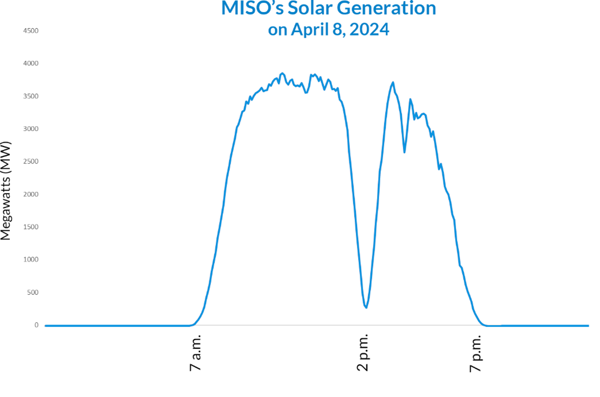
The big story from April 8 is that MISO did its job as the glorious celestial phenomenon passed through the footprint. That’s not to say that our operators had an uneventful day (balancing the grid is never straightforward). But advanced risk analysis and forethought enabled the hours of darkness to pass without operational incident. Many operators even got the chance to venture outside for a quick look.
Solar power, eclipsed
MISO entered eclipse day well-positioned to manage the variability in electricity demand, cloud coverage, solar generation and congestion. Our team made advanced market adjustments to ensure we would have plenty of grid flexibility and generation.
Our Central region had clear skies — as a result, the eclipse triggered rapid, significant changes in system conditions. Before the eclipse began, MISO’s systemwide solar generation neared 4,000 MW (almost 75% of our solar capacity). Generation dropped more than 3,700 MW to under 300 MW when totality reached our Carmel, Indiana control room. It jumped right back up after the eclipse passed.

A balancing authority of MISO's size requires the entire team of operators working together to achieve reliability, especially during a systemwide event. “The risk and uncertainty of this unique day made balancing the grid pretty stressful, and we had to think several moves ahead because of how quickly the moon’s shadow moved through the footprint” said James Bostwick, MISO’s primary balancing authority operator (BAO) for the day. “The planning and additional reserves we set up for the day allowed us to successfully maintain reliability while ensuring system demand, generation, and transfers to and from our neighbors remained balanced.”
Other effects: demand and wind
The eclipse didn’t have a particularly unusual influence on our system’s demand for electricity. But we did see a slight drop (3.5% or about 2,500 MW) when totality hit in our Central region. Probably because people were outside, not in, watching in awe.
One of the biggest variabilities our operators experienced was a quick, steep drop in wind generation. Our data shows wind dropped 35% (5,500 MW) over the course of 90 minutes. The change created a unique challenge when it came to balancing electricity supply and demand.
All about collaboration
Before, during, and after the eclipse, MISO communicated with its members often using the new Operator Interface. We wanted to ensure all were well informed of MISO’s plans and actions throughout the day. As always, MISO also coordinated closely with our neighbors to keep power flowing across our region and the eastern interconnection.
“Planning and coordination are key to success with these types of events. In real time, communication, adaptation and execution are paramount when responding to large dynamic system changes such as this total solar eclipse,” reflected Bostwick. “I think we did well across the board.”